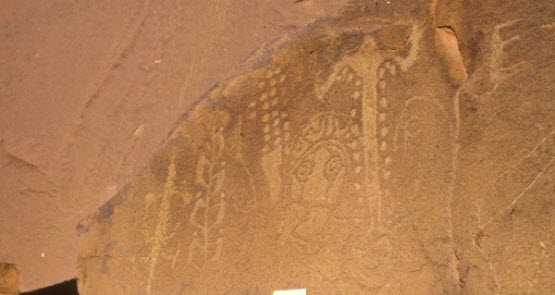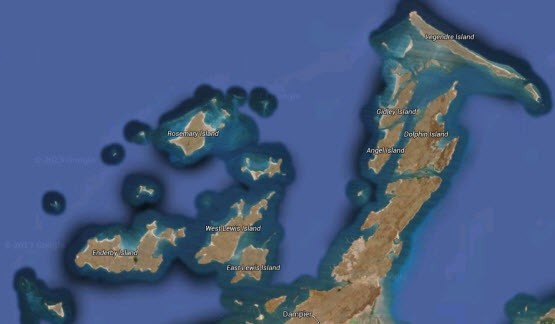
A bitter row has broken out over a bid to have priceless 30,000-year-old rock art granted World Heritage status, with the CEO of a local Aboriginal corporation coming out against the listing, contrary to the wishes of prominent indigenous leaders.
The million rock engravings located on Western Australia’s Dampier Archipelago on the Pilbara Coast are believed to contain the earth’s oldest representation of a human face and were prominently featured on ABCTV’s groundbreaking First Footprints series on Sunday night.
Proponents say inclusion on the UNESCO World Heritage List would safeguard the treasures forever and protect them against wanton environmental destruction at the hands of resources giants like gas behemoth Woodside.
The CEO of local group the Murujuga Aboriginal Corporation (MAC), Ron Critchley, appears to be at odds with his 12-member indigenous board over the listing, which he personally opposes. On the other side sits campaigners Stand Up for the Burrup, Greens Senator Scott Ludlam and a clutch of local Aboriginal elders including Wong-goo-tt-oo man Wilfred Hicks, spokesperson for Tim Douglas, Burrup Senior Law Man.
Supporters of the World Heritage listing say an informal arrangement exists between Critchley and the WA Nationals leader and local MP Brendan Grylls to grant MAC further control over waterways off the Dampier coast. The Barnett government is bitterly opposed to a World Heritage status, fearing it would throttle resources extraction in the gas-drenched North West Shelf region — responsible for 4% of Australia’s GDP — and could spark a rash of similar claims. The Murujuga National Park was proclaimed this year to cover some 42% of the region, but other areas are slated by the government for future industrial development.
Earlier this month, Critchley travelled to Canberra with two elders to discuss the issue. He confirmed to Crikey the visit took place and that he met with officials from the Department of Sustainability, Environment, Water, Population and Communities (SEWPaC) about current funding arrangements. He told Crikey he was there for the opening of the Hipbone Sticking Out festival, of which Woodside’s Pluto LNG plant is the principal sponsor. Woodside is the de-facto oil and gas company in the region and works closely with MAC.
Critchley confirmed that “Woodside are actually funding our ranger program through that conservation agreement that they entered into with SEWPaC. They’re funding the program for its initial start-up years and they’re also funding our cultural management plan.”
That trip followed hot on the heels of another, pro-Heritage, trip. On June 19, the two senior Burrup custodians, Douglas and Hicks, travelled from Roebourne to Canberra and met with then-environment minister Tony Burke. A letter signed by eight Ngarda Ngarli elders — including representatives of all groups represented on MAC — called on Burke to “urgently act on our pleas to formally nominate the Dampier Archipelago and including the Burrup Peninsula to the World Heritage Authority”.
Despite the signed letter, Critchley maintains he has the support of his board, spread across the Ngarluma, Yinjibarndi, Wong-goo-tt-oo and Yaburara-Mardudhunera groups. The corporation was set up in 2003 as a trust to receive compensation monies from the state government for the state’s compulsory acquisition of the Burrup land.
He told Crikey he had a “different stance” to the other group: “The state government is dead-set against the World Heritage here and that’s just a given fact. And we have just taken over running the national park and so we want to show the state government that the whole area can be managed well by the local Aboriginal people before we start.
“Our stance is that we’ll prove to the government that we can run it properly first and then we’ll put pressure on them to do the World Heritage at a later stage. We see no value in pressing it at this stage because the state government will just come up against it and say ‘no’.
“We’re looking after the whole archipelago with its national heritage areas, which is bigger than the national park itself. So we’re of a view that we can just show the government we can look after it and that it can work with industry because that’s the state government’s biggest concern, with all the industry there it’s not a good look. So we’re saying well, ‘we can exist can run side by side’.”
Crikey asked Critchley whether there was an understanding with the state government that MAC would soon take over greater management of additional islands and waterways. “We want to get the waters in between,” he said. “We haven’t got the waters yet … the state government’s going to make that a marine park and we’ll take over management of that as well.” He confirmed Grylls “was aware of our situation and is supportive”.

He claims a recent Australian Heritage Council report broadly supportive of the listing said “categorically that nothing will happen until they talk to MAC”. It said the argument for Heritage listing would be “significantly strengthened” if further work was undertaken with the local indigenous community.
But the chair of the Australian Heritage Council, former WA premier Carmen Lawrence, refuted that suggestion, telling Crikey: “It would be a mistake to give one body such prominence when others might claim an interest. It would be a mistake to focus on specific groups.”
Mark Lawrence, a South Australian lawyer and co-ordinator of the Stand up for the Burrup campaign, says support for World Heritage status is almost unanimous and Critchley is driving the opposition.
“Mr Critchley has ambitions to control more land and water under the Murujuga Aboriginal Corporation’s control and he’s going against the policies and stated wishes of the Aboriginal people for immediate World Heritage listing. He’s an agent for the Western Australia government and Woodside and he should make full disclosure.”
A spokesperson for new federal Environment Minister Mark Butler’s office did not respond to Crikey‘s queries for this story. Brendan Grylls is overseas and his office also failed to respond.









The art is most likely an anthropomorphized depiction of high-energy plasma events in the sky thousands of years ago — truly priceless.
http://thunderbolts.info/tpod/2005/arch05/050506plasma-rock-art.htm
The paintings are forever, while the mines will come and go.
Mines are easy to replace but the paintings are irreplaceable. The miners on the job probably understand this more than the suits.
Truly shameful short sighted greedy vandalism.
They must not be destroyed.
Maps 101: always include a scale. Pretty meaningless otherwise, especially in this instance.